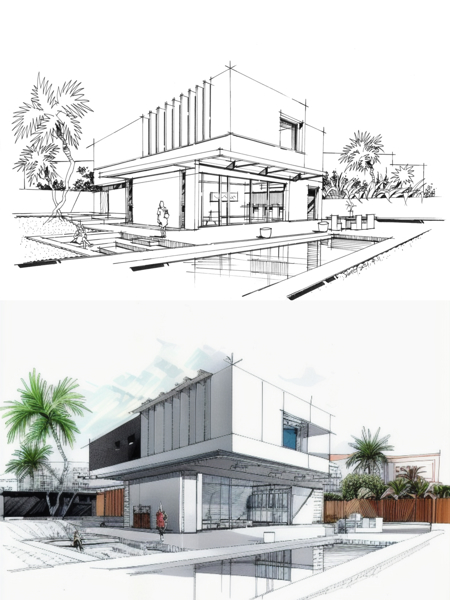The Effect of Technical Innovations on the Design Practices of Contemporary Architects
The fast advancement of technical devices has dramatically improved the layout landscape for modern engineers, cultivating extraordinary degrees of technology and sustainability. Exploring these dynamics discloses a nuanced interaction in between technology and typical style techniques, motivating a better evaluation of what the future holds for architectural techniques.
Advancement of Architectural Equipment
How have building devices changed the design and building and construction processes over the centuries? The evolution of building tools has actually dramatically affected the efficiency, precision, and creative thinking of style and building.
With the advent of the Renaissance, the intro of the compass and the protractor marked a pivotal change. These tools allowed architects to attain greater precision in their designs, helping with the appearance of more complex and proportionate buildings. The Industrial Revolution additionally revolutionized architectural exercise with the intro of mechanized devices and products, allowing for bigger and much more enthusiastic projects.
In the 20th century, the advancement of computer-aided layout (CAD) software application changed the landscape once more, giving architects with unmatched capabilities in modeling and visualization. Today, advanced devices such as Building Info Modeling (BIM) and parametric layout software program remain to push the boundaries of architectural technology, enabling a much more incorporated strategy to layout and building and construction procedures.
Boosted Cooperation in Layout
As modern technology proceeds to advance, boosted collaboration in design has become a foundation of contemporary building method. The combination of digital tools such as Structure Details Modeling (BIM), cloud-based systems, and advanced visualization software has changed the method designers, engineers, and stakeholders connect throughout the layout process. These tools facilitate real-time interaction, enabling teams to share concepts, adjustments, and feedback quickly, despite geographical area.

Furthermore, interdisciplinary collaboration has been structured through these technical advancements, allowing engineers to work more closely with various other specialists, such as urban organizers and environmental specialists. The outcome is a more cohesive method to create that considers different perspectives and expertise. Eventually, boosted partnership in style is not just a fad; it is necessary for developing innovative, useful, and cosmetically pleasing style in an increasingly intricate globe.
Sustainability Via Technology
Sustainability in architecture has increasingly ended up being intertwined with technological innovation, driving the industry towards ecologically liable methods - cda architects. Contemporary architects are leveraging sophisticated technologies to decrease environmental impact while enhancing the efficiency of buildings. One noticeable instance is the use of Building Details Modeling (BIM), which permits basics precise planning and source allotment, lowering waste during building and advertising power efficiency throughout a building's lifecycle
Additionally, smart materials and energy-efficient systems are being incorporated right into designs to enhance source use. Technologies such as solar batteries and environment-friendly roofing systems harness renewable resource sources, contributing to lowered carbon footprints. Additionally, the application of synthetic knowledge in layout processes allows designers to imitate and assess power consumption, guiding decisions toward even more sustainable outcomes.
The assimilation of lasting modern technologies not just straightens with worldwide ecological objectives but additionally satisfies a boosting need from consumers for environmentally friendly remedies. As architects accept these innovations, the emphasis shifts towards producing areas that are not only cosmetically pleasing however additionally functionally sustainable, thereby redefining the standards of modern-day architecture. By doing this, innovation offers as a catalyst for sustainability, allowing designers to create structures that respect and improve the natural environment.
Difficulties in Application
While technological innovations in style hold terrific guarantee for boosting sustainability, their execution typically comes across substantial challenges - cda architects. One key obstacle is the steep understanding curve connected with brand-new technologies. Engineers and building and construction specialists might need comprehensive training to effectively utilize hop over to here innovative software and tools, which can postpone job timelines and raise prices
Additionally, the integration of emerging technologies, such as Structure Info Modeling (BIM) and sustainable products, commonly necessitates collaboration throughout multidisciplinary groups. This collaboration can be prevented by distinctions in know-how, operations, and communication styles, resulting in possible disputes and inadequacies.
Financial constraints additionally make complex the fostering of cutting-edge innovations. Lots of building firms, especially smaller sized ones, may do not have the sources to purchase advanced tools, restricting their capability to take on bigger firms that can manage such financial investments.
Furthermore, regulatory frameworks and building ordinance may not keep speed with technological advancements, creating ambiguity and potential conformity issues. This challenge can inhibit engineers from fully accepting brand-new technologies, as the danger of non-compliance may surpass the benefits. Addressing these execution difficulties is important for the successful assimilation of technical developments in modern architectural methods.
Future Trends in Architecture
The challenges connected with the application of new modern technologies in architecture have triggered a reevaluation of future fads within the sector. As architects browse problems such as sustainability, urbanization, and social equity, they are increasingly adopting ingenious innovations to enhance style efficiency and environmental efficiency.
One popular fad is the integration of expert system (AI) in the layout process. AI devices can examine vast datasets to educate design decisions, boosting both imagination and capability. Similarly, Structure Info Modeling (BIM) remains to progress, making it possible for real-time partnership amongst stakeholders and helping with structured project management.
Sustainable design methods are additionally obtaining momentum, with architects concentrating on flexible reuse and regenerative layout concepts that minimize source consumption and waste. The consolidation of wise products and renewable resource sources will even more improve the durability of structures despite environment adjustment.

Conclusion
Technical developments have actually considerably improved architectural design techniques, assisting in boosted precision, cooperation, and sustainability. The integration of tools such as Structure Information Modeling and parametric style software, along with expert system and smart materials, equips architects to address complicated obstacles a lot more successfully. While implementation may provide particular barriers, the continued evolution of these modern technologies guarantees to drive innovation in architecture. Future patterns will likely better emphasize sustainability and efficiency, eventually he said redefining the developed setting.